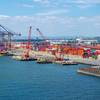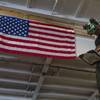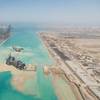Maersk Inc. has committed to the building of a new state-of-the-art container terminal in the Port Of Los Angeles' Pier 400 facility.
The Port of Los Angeles and Maersk Inc. signed a Memorandum of Understanding, agreeing to negotiate to reach a final lease agreement. The lease agreement is subject to regulatory approval of the A.P. Moller-Maersk Line acquisition of Sea-Land International and must also be approved by the boards of A.P. Moller and Maersk Inc., the Los Angeles Harbor Commission and the Los Angeles City Council.
In making the Port of Los Angeles its new West Coast hub, Maersk Sealand will bring the port about $2 billion over its 25-year lease. The agreement represents an economic boost to the city and regional economy, with projections for thousands of jobs, approximately $1.7 billion in industry sales, and more than $500 million in wages. As a result of the agreement, the port will reclaim its position as the United States' number one port.
"This is a great day for the Port of Los Angeles and the City of Los Angeles," said L.A. Mayor Richard Riordan. "Maersk Sealand's commitment will bring our city thousands of quality jobs and billions of dollars in new investment."
Upon completion, the Pier 400 terminal will comprise 484 acres. As the world's largest proprietary container terminal, it will serve as the southern terminus of the Alameda Corridor transportation project and will effectively prepare the port for an anticipated doubling of cargo that is expected to move through the San Pedro Bay in the next 20 years.
The cost of the Pier 400 project is $794 million, which includes $466 for the container terminal facilities and infrastructure and $328 million for two stages of a massive dredging and landfill program.
It is expected that the container terminal will have the capacity to boost the port's current annual volume of 3.5 million teu to more than 4 million teu, repositioning the port as the nation's busiest for at least the next 25 years. Los Angeles was the number one port from 1989 to 1993 when it surpassed the New York/New Jersey Port Authority. In 1994, Los Angeles moved to the number two position behind the Port of Long Beach.
"This new partnership is a great investment," said Harbor Commission President Ted Stein. "By choosing Pier 400, Maersk Sealand benefits from unsurpassed facilities at the premier port in America, giving them a competitive edge to remain a leader in the global marketplace."
The Pier 400 Container Terminal will include a first-class intermodal rail facility, providing the capability to rapidly and seamlessly transfer goods from ship to on-dock rail. The intermodal transfer capability includes 12 working tracks to handle four intermodal trains.
A dedicated transportation corridor will provide Pier 400 with direct access to the rail and highway expediency of the Alameda Corridor, a 20-mile road and rail expressway scheduled for completion in early 2002.
The container terminal will be constructed in two phases, creating the most effective facilities, infrastructure and technology to provide for a seamless flow of products. The initial 288-acre phase will be ready for customer use by the end of 2001. When phases one and two are complete and operational in 2003, the 484-acre facility will offer 7,190 lineal feet of wharf, six berths with a water depth of -55 ft. and the capacity to work six vessels at one time. The pier features an approach channel and a 1,800 ft. diameter turning basin. The facility will also include at least 16 shoreside cranes.
"Our rate of growth demands that we constantly and rapidly strengthen our infrastructure," said Phillip V. Connors, executive vice president of Maersk Inc. "The Pier 400 facility is of strategic importance to our global network plan to meet the growing demands of world trade and customer satisfaction."
Subscribe for
Maritime Reporter E-News
Maritime Reporter E-News is the maritime industry's largest circulation and most authoritative ENews Service, delivered to your Email five times per week









